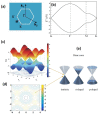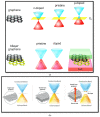Graphene-Induced Performance Enhancement of Batteries, Touch Screens, Transparent Memory, and Integrated Circuits: A Critical Review on a Decade of Developments
- PMID: 36144934
- PMCID: PMC9503183
- DOI: 10.3390/nano12183146
Graphene-Induced Performance Enhancement of Batteries, Touch Screens, Transparent Memory, and Integrated Circuits: A Critical Review on a Decade of Developments
Abstract
Graphene achieved a peerless level among nanomaterials in terms of its application in electronic devices, owing to its fascinating and novel properties. Its large surface area and high electrical conductivity combine to create high-power batteries. In addition, because of its high optical transmittance, low sheet resistance, and the possibility of transferring it onto plastic substrates, graphene is also employed as a replacement for indium tin oxide (ITO) in making electrodes for touch screens. Moreover, it was observed that graphene enhances the performance of transparent flexible electronic modules due to its higher mobility, minimal light absorbance, and superior mechanical properties. Graphene is even considered a potential substitute for the post-Si electronics era, where a high-performance graphene-based field-effect transistor (GFET) can be fabricated to detect the lethal SARS-CoV-2. Hence, graphene incorporation in electronic devices can facilitate immense device structure/performance advancements. In the light of the aforementioned facts, this review critically debates graphene as a prime candidate for the fabrication and performance enhancement of electronic devices, and its future applicability in various potential applications.
Keywords: field effect transistor; flexible electronics; graphene; nanomaterial; touch screen; transparent electronics.
Conflict of interest statement
The authors declare no conflict of interest.
Figures














References
-
- Wallace P.R. The Band Theory of Graphite. Phys. Rev. 1947;71:622–634. doi: 10.1103/PhysRev.71.622. - DOI
-
- Boehm H.P., Clauss A., Fischer G.O., Hofmann U. Dünnste Kohlenstoff-Folien. Z. Nat. B. 1962;17:150–153. doi: 10.1515/znb-1962-0302. - DOI
-
- Boehm H.P., Setton R., Stumpp E. Nomenclature and Terminology of Graphite Intercalation Compounds (IUPAC Recommendations 1994) Pure Appl. Chem. 1994;66:1893–1901. doi: 10.1351/pac199466091893. - DOI
Publication types
LinkOut - more resources
Full Text Sources
Miscellaneous

